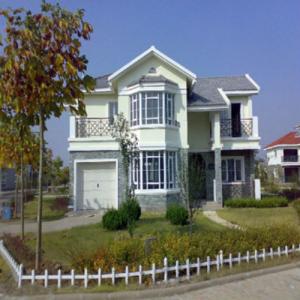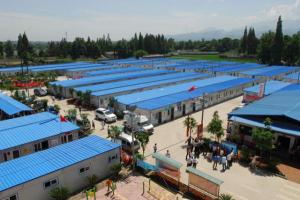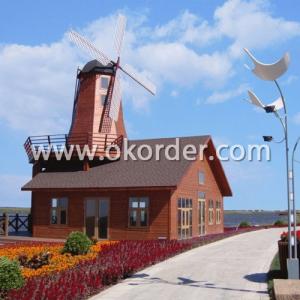Beautiful wooden house
- Loading Port:
- China Main Port
- Payment Terms:
- TT OR LC
- Min Order Qty:
- -
- Supply Capability:
- -
OKorder Service Pledge
OKorder Financial Service
You Might Also Like
Beautiful wooden house / wooden house bungalow:
ISO standard light gauge steel for main structure.one or two also three floors available.fireproof,heat insulation,wind and earthquake resistance.green,energy save. economically.
wooden house bungalow design code:
(1 AISI S100 North American Specification for the Design of Cold Formed Steel Structural Members published by the American Iron and Steel Institute (AISI) in the United States.
(2)AS/NZS 4600 Australian/New Zealand Standard-Cold-formed steel structures jointly published by Standards Australia and Standards New Zealand.
(3)BS 5950-5 Structural use of steelwork in building-Part 5. Code of practice for design of cold formed thin gauge sections published by BSI in the UK.
(4)ENV1993-1-3 means Eurocode 3: Design of steel structures; Part 1.3: General rules, Supplementary rules for cold-formed thin gauge members.
Our primary services include Design, Engineering, Manufacture, Drafting, and Installation of light gauge steel framed structures from design through to Turn-Key.
- Q:Can container houses be used for temporary housing solutions?
- Certainly, container houses can be utilized for temporary housing solutions without a doubt. Known as shipping container homes, container houses are growing in popularity due to their affordability, durability, and versatility. These structures are constructed from repurposed shipping containers, typically made of steel and designed to withstand harsh weather conditions and transportation. The mobility of container houses is one of their key advantages for temporary housing solutions. They can be easily transported and relocated to different sites, making them perfect for short-term housing needs. Setting up and dismantling them is quick, providing flexibility to meet various temporary housing requirements such as disaster relief, construction worker camps, refugee camps, or temporary workforce accommodations. Container houses can also be customized and modified to cater to specific temporary housing needs. They can be equipped with amenities like insulation, plumbing, electrical systems, heating and cooling, as well as furniture and fixtures, ensuring comfortable living conditions. Additionally, container houses can be stacked or combined to create larger living spaces or multi-unit structures, making them suitable for accommodating larger groups or families. Furthermore, container houses offer an environmentally friendly solution for temporary housing needs. By repurposing shipping containers, this housing option reduces waste and promotes sustainability. It also minimizes the demand for traditional construction materials and processes, resulting in a lower carbon footprint. While container houses may not provide the same level of comfort or aesthetic appeal as traditional houses, they offer a cost-effective and efficient solution for temporary housing needs. They have already proven successful in various temporary housing projects worldwide and continue to gain recognition as a viable option for addressing housing challenges during emergency situations or transitional periods.
- Q:How long does it take to build a container house?
- The length of time it takes to build a container house can vary depending on several factors. On average, a container house can be built within 2 to 4 months. However, this timeline can be influenced by factors such as the size and complexity of the design, the availability of labor and materials, the weather conditions, and the level of customization desired. If you opt for a basic and straightforward design, the construction process can be completed relatively quickly. This includes preparing the site, laying the foundation, modifying and assembling the shipping containers, and adding necessary utilities and finishes. In such cases, the construction can be finished within the shorter end of the 2 to 4-month range. However, if you have a more complex design in mind or require extensive customization, it might take longer to complete the construction. This could involve additional structural modifications, insulation, plumbing, electrical work, and interior finishes. The more intricate the design and the more customized features you incorporate, the longer the construction process may take. Furthermore, external factors such as obtaining necessary permits, inspections, and the availability of skilled labor and materials can also impact the overall timeline. Adverse weather conditions, such as heavy rain or extreme cold, can also cause delays in construction. Ultimately, it is crucial to consider your specific requirements, budget, and timeline when embarking on a container house project. Consulting with professionals and experienced contractors will provide a more accurate estimate of the time needed to build a container house based on your unique circumstances.
- Q:Can container houses be designed with a small footprint?
- Yes, container houses can be designed with a small footprint. Their modular nature allows for flexibility in design and layout, making it possible to create compact and efficient living spaces. Additionally, incorporating sustainable features such as solar panels and rainwater harvesting systems further reduces their environmental impact.
- Q:What are the design options for container houses?
- The design options for container houses are diverse and versatile. They can range from a simple, minimalist layout to a more complex and spacious design. Some popular design options include open floor plans, multiple levels, and creative use of windows and doors for natural light. Additionally, container houses can be customized with various exterior finishes, such as cladding, paint, or even green roofs, allowing for a wide range of aesthetic possibilities.
- Q:Buy second-hand villa need to pay attention to what?
- Whether it is the plot of the internal landscape or landscape and other external resources are the value of product preservation and value-added value
- Q:Are container houses suitable for remote education or homeschooling?
- Depending on personal preferences and circumstances, container houses can serve as a viable choice for remote education or homeschooling. These houses typically boast a small size and can be tailored to suit specific requirements, enabling the creation of a dedicated learning area within the home. One of the advantages of container houses for remote education or homeschooling lies in their affordability. Constructing a container house can be a cost-effective alternative to conventional homes, allowing families to save on housing expenses and allocate more resources towards education. Moreover, container houses can be easily customized and expanded as needed, providing flexibility for families with growing children or evolving educational needs. Furthermore, container houses are highly portable, enabling convenient transportation to different locations. This portability proves advantageous for families who prefer frequent travel or relocations while still maintaining a stable learning environment. This adaptability can be particularly beneficial for families engaged in remote work or seeking to expose their children to diverse cultures and experiences. However, it is important to acknowledge that container houses may have space limitations. Despite efforts to maximize available area through customization, accommodating multiple children or creating separate study spaces within a compact structure may present challenges. Therefore, careful planning of the interior layout and consideration of the specific educational needs of those involved are crucial. Ultimately, the suitability of container houses for remote education or homeschooling hinges on individual preferences, budget constraints, and the ability to adapt to a smaller living space. Families prioritizing affordability, portability, and creativity in designing their learning environment may find container houses to be a practical and distinctive option for remote education or homeschooling.
- Q:Are container houses suitable for disaster relief efforts?
- Yes, container houses are suitable for disaster relief efforts. Container houses, which are made from repurposed shipping containers, have several advantages that make them a viable option for providing temporary housing in disaster-stricken areas. Firstly, container houses are readily available and can be quickly deployed to disaster zones. Shipping containers are abundant and can be easily transported by land, sea, or air. This allows for a rapid response to provide shelter for displaced individuals and families, minimizing the time spent without proper housing. Secondly, container houses are durable and weather-resistant. They are built to withstand harsh conditions during transportation, making them ideal for disaster-prone areas. These structures can withstand extreme weather events such as hurricanes, earthquakes, and floods, providing a secure and safe living environment for those affected by disasters. Additionally, container houses are cost-effective compared to traditional housing solutions. The use of repurposed shipping containers reduces construction costs, making it more affordable to provide housing for a larger number of people. Moreover, these structures can be easily modified and customized to meet the specific needs of disaster-affected communities. Furthermore, container houses are environmentally friendly. By repurposing shipping containers, we reduce waste and promote sustainability. These structures can be designed to be energy-efficient, incorporating renewable energy sources and eco-friendly materials, further minimizing their environmental impact. Lastly, container houses offer a sense of stability and privacy to those affected by disasters. They provide individuals and families with a personal space they can call their own during a challenging time. These structures can be designed to include basic amenities such as bathrooms, kitchens, and beds, ensuring that the basic needs of the occupants are met. In conclusion, container houses are a suitable option for disaster relief efforts. Their availability, durability, cost-effectiveness, environmental friendliness, and ability to provide a sense of stability make them an excellent choice for providing temporary housing in disaster-stricken areas.
- Q:Are container houses portable?
- Indeed, container houses possess the quality of being portable. The primary benefit of container houses lies in their mobility and convenient transportation. These dwellings are constructed from shipping containers, which are specifically engineered for shipment via ships, trucks, and trains. With their standardized dimensions and inclusion of corner castings and twist locks, these containers can be effortlessly loaded and unloaded onto various modes of transportation. Container houses have the ability to be transported and swiftly installed in any desired location, making them highly sought-after for temporary or mobile housing solutions. Moreover, if the situation calls for it, container houses can be readily disassembled and relocated to a new destination.
- Q:Can container houses be built with a traditional living room setup?
- Certainly! Container houses can definitely incorporate a traditional living room arrangement. These houses offer immense customization options, enabling the creation of various floor plans and interior layouts that include a traditional living room setup. It is possible to modify the containers themselves to create spacious areas, perfect for a living room with comfortable seating, entertainment systems, and classic furniture like sofas, coffee tables, and TV stands. Furthermore, container houses can be expanded or joined together to generate larger living spaces, providing even greater flexibility in designing a traditional living room setup. With careful planning and design, container houses can deliver all the comforts and functionality of a conventional home, complete with a warm and welcoming living room.
- Q:In the steel frame with foam sandwich color plate to do the floor, above the cement paste tile, so ok?
- Color steel plate, refers to the color coated steel plate, color coated steel plate is a kind of organic coating with steel plate.
1. Manufacturer Overview |
|
|---|---|
| Location | |
| Year Established | |
| Annual Output Value | |
| Main Markets | |
| Company Certifications | |
2. Manufacturer Certificates |
|
|---|---|
| a) Certification Name | |
| Range | |
| Reference | |
| Validity Period | |
3. Manufacturer Capability |
|
|---|---|
| a)Trade Capacity | |
| Nearest Port | |
| Export Percentage | |
| No.of Employees in Trade Department | |
| Language Spoken: | |
| b)Factory Information | |
| Factory Size: | |
| No. of Production Lines | |
| Contract Manufacturing | |
| Product Price Range | |
Send your message to us
Beautiful wooden house
- Loading Port:
- China Main Port
- Payment Terms:
- TT OR LC
- Min Order Qty:
- -
- Supply Capability:
- -
OKorder Service Pledge
OKorder Financial Service
Similar products
New products
Hot products




























